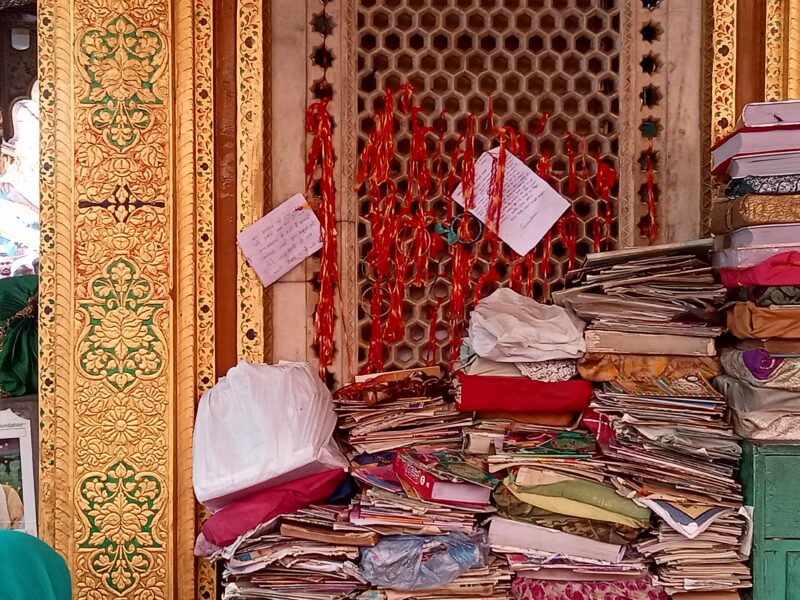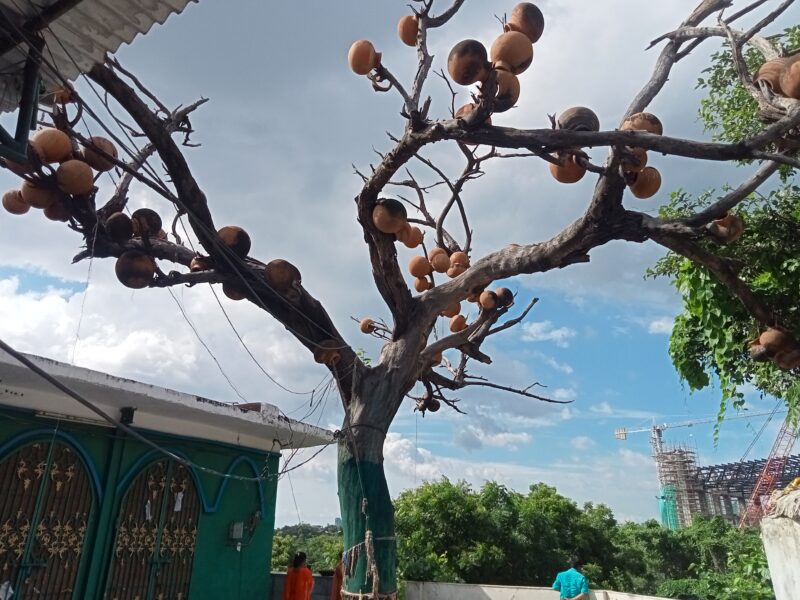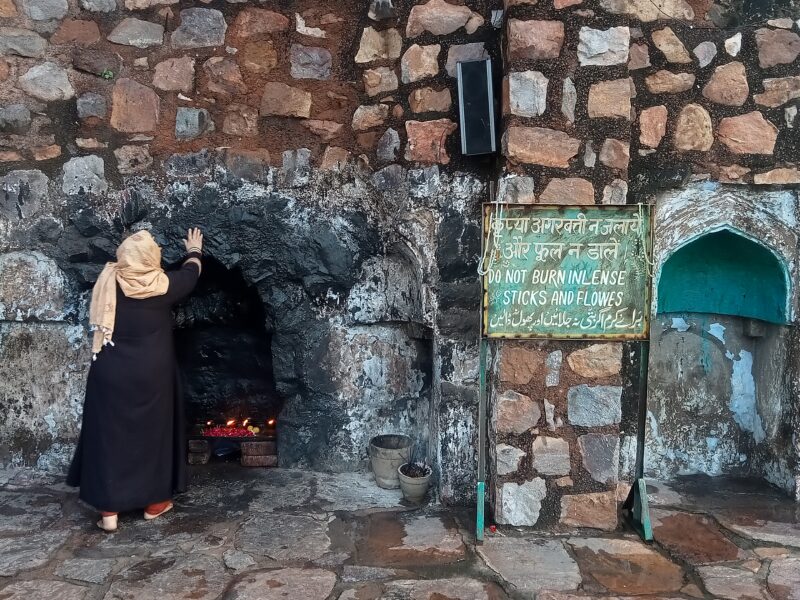Be it a severe problem or a petty one, people flock to dargahs to seek help from Sufi saints and djinns using wish-slips, threads, and even clay pots. Patriot interacts with such supplicants and the caretakers of these places to understand the significance of such prayers and beliefs
“Sarkar, jo Rani* ke saath shaitaan gandi harkat karta hai usey khatam kardo aur uski shaitan se hifazat karo”, (Chief, please end the evil things Satan does to Rani* and protect her from it), reads a parcha (wish-slip) at the dargah of Sufi Sarmad Shaheed. The wish-slip is addressed to a powerful ‘Sarkar’ – here, the Sufi saint buried in the dargah. Another such slip requests to remove the obstacles of an interfaith marriage.
The dargah, located at the foot of Jama Masjid in old Delhi, has several such wish-slips. Almost all of them, as if following a custom, end with an apology for mistakes made in writing the wishes or expressing the feelings.
Wish-slips are letters addressed to Sufi saints at dargahs that request their intercession for shifa-at (cure) and barkat (blessings). Generally known as arziyan (applications) among believers, these are often accompanied by personal belongings such as bangles, photographs, padlocks, rings and coins. Some of them are photocopied petitions addressed to multiple saints and tied at various sacred places to make the case stronger and garner the blessings of all religious figures.

Mohd Salauddin, 25, who came to Nizamuddin Dargah for a mannat (prayer) with his mother, believes that it is the faith and belief of the wisher that fulfill the wishes. “There must be a reason why so many people do it. If you believe in it, your request will be fulfilled”, he says. His mother knots a thread on a carved wooden window screen of the dargah as she makes a wish. The action is followed by a prayer.
Apart from wish-slips, dor bandhna (thread-knotting) is another common practice for making a wish – which, according to another supplicant present at the dargah, is a common practice among women. If the wish is fulfilled, a nazrana (gift) is offered out of respect for the intercession and the locks are removed. In case of wish-slips, they too are untied.
Interestingly, several people believe that such ‘healings’ transcend medical treatment. According to a woman who did not wish to be named, she had tried everything for the wellness of her daughter, before she decided to make an arzi (appeal) at the dargah of Syed Badruddin Samarqandi at the foot of Feroz Shah Kotla. “This is my last hope. I have heard so much about the sarkar’s karamaat (wonders)”, she cries as she recites a prayer on her lips.
Call of the supernatural
In case of supernatural involvement, which is commonly called hawaa (evil possession), it is believed that the Sufi saints ‘call’ the ones who are possessed to their abode. Legend has it that a lot of people come running from miles once they are called to give their haazri (attendance) at the dargah.
Abdul Qayyum, now in his forties, recites a famous local poem about the ‘call’ of Sufi saint Nizamuddin, explaining the state of those possessed. “A lot of possessed people who come here, give bayaan (announcements) about how evil possessed them. It is not them who are speaking. It is the Shaitan or the djinn speaking from them”, he says. When inquired about how people are possessed, he replies that it is best known to the ‘Sarkar’ and the conversation between them.
Qayyum has been living in Nizamuddin Dargah since “time immemorial.” He makes an interesting point about how maulvis living in the dargah are just making money from people’s wishes and suffering. Asked to further explain this, he just says, “Only Sarkar knows better.”
While wish-slip and thread remain a predominant practice for wish-making, there are other props that supplicants use at various religious locations. In Matka Peer Dargah of Hazrat Sheikh Abu Bakar, located near Pragati Maidan, devotees offer matkas (clay pots) whenever their prayers are answered, and at times, to pay their respects.
Haji Sufi Mohammad Tehseen, caretaker of the dargah, narrates the legend of its close association with clay pots. The saint reportedly used water from his Khanqah to heal a man of a sickness that the doctors of the time had given up on. The Sultan, Ghiyasuddin Balban, sent clay pots filled with mud and iron balls to the hermit as an offering after learning of the incident. The saint covered the pots and started praying.

As he prayed, the covers were lifted to reveal the mud and iron balls now replaced with roasted gramme and jaggery. Since then, both – the name “Matka Peer” and the gifts – have endured.
Nisar Ahmad, a resident of Shastri Park, often visits the dargah along with his wife and a friend. He claims that the wish he had made has already been fulfilled and he had offered a matka a long time ago. Ever since, he has been an ardent visitor at the place and recommends it to those who are facing difficulties.
“I have a firm belief that all your prayers will be answered”, he remarks. Once the prayers are answered, the devotees offer chana, jaggery and milk.
However, general advice all the devotees gave was to have a well-intentioned heart and a paak-saaf (pure) wish. “If your wish is to harm others or something which is impure or lowly, this is not a place you should visit”, says Ishtiaq Alam, a visitor at the dargah.
Where djinns reign
At Feroz Shah Kotla, a palace complex built by Sultan Feroz Shah Tughlaq, there is one exception that draws the devotees en masse: instead of Sufi saints, the djinns serve as a portal to the supernatural and wish-granting world. The interaction with the djinn-saints remains the same as in a Sufi dargah.
The devotees flock to the ruins every Thursday after 2 pm. The ritual is observed regardless of religion, mostly by the working class people of Delhi. An eerie feeling engulfs the heart as several heretics casually announce the many wonders of the djinns. Several women knot their petitions on the iron fences of the ruins and pray to the empty chambers.
According to Islamic theology, djinns are spirits thought to have been made of smokeless fires, while humans are made of clay. Unlike humans, djinns have supernatural powers and exist with humans in an unseen world (al-ghayb). They can possess humans, grant wishes, and meddle with their lives at their own accord.

Interestingly, in Feroz Shah Kotla, there is a Ministry of Djinns that handles the petitions made by the believers. The body functions like an ordinary bureaucracy with an elaborate hierarchy of different departments that deal with different problems.
A priest sitting near the cave-like chambers of the ruins says that people visit the place because of the presence of “shahshahs” – the djinns – instead of “buzurg” – the saints. “The walis (a term used for Sufi saints) here are the djinns”, he says. “These djinns answer all the prayers of their followers. These powers reside here because it is their abode. If you light a bulb here, it will be fused. It is because they do not want to be meddled with their existence”, he adds.
However, a number of people doubt the existence of such powers. The Imam of the Jami Masjid at Feroz Shah Kotla says that it is the illiteracy and difficulties of the people that compel them to trust in such “lies.” The Imam has put up boards prohibiting the knotting of wish-slips and burning of diyas (earthen oil lamps), but people seem to ignore it.
According to Ather Ali*, a resident of Ghaziabad, his prayers have been answered time and again for the last ten years. “I know the Imam does not believe in such things. But I am a witness that there are djinns here who answer every prayer”, he says.
When Patriot asked the Imam about the claim of so many devotees about the presence of djinns, he remained undeterred. “Where are they not?”, he retorted, implying the existence of the unseen world as per Islamic theology.
*Names changed to protect identities
For more stories that cover the ongoings of Delhi NCR, follow us on:
Instagram: instagram.com/thepatriot_in/
Twitter: twitter.com/Patriot_Delhi
Facebook: facebook.com/Thepatriotnewsindia





